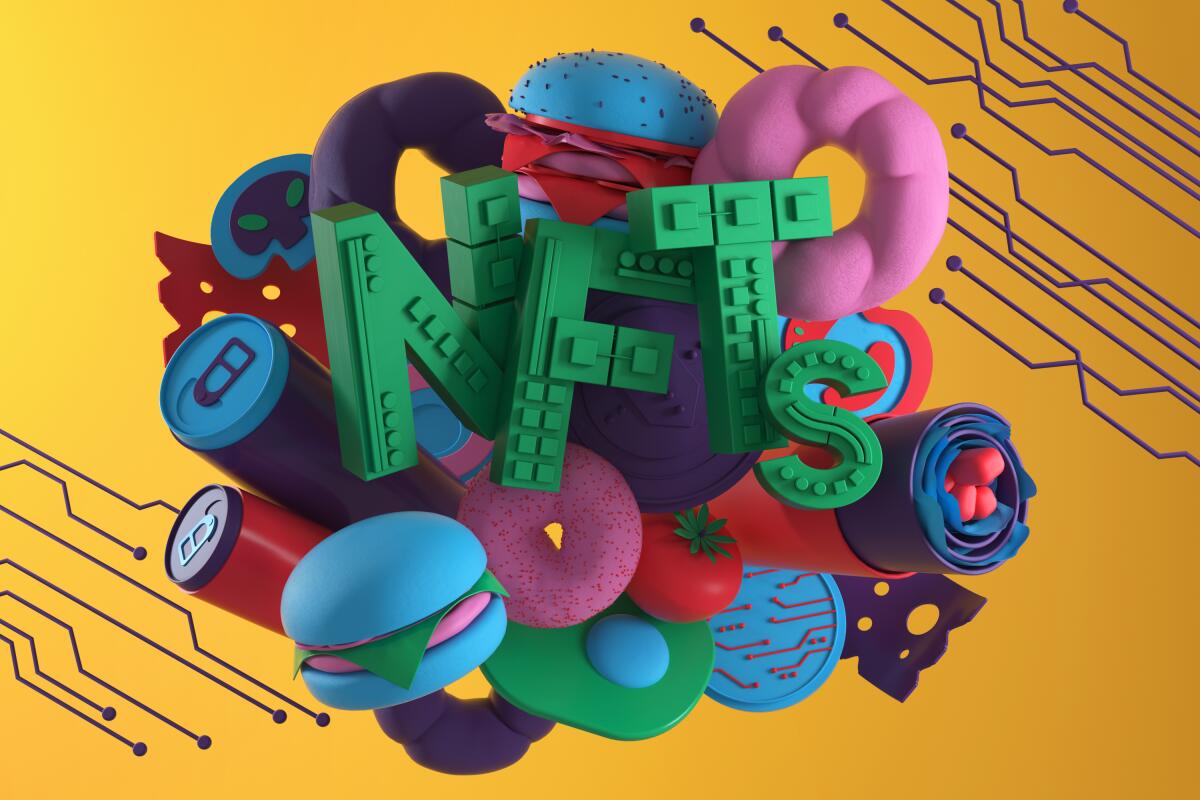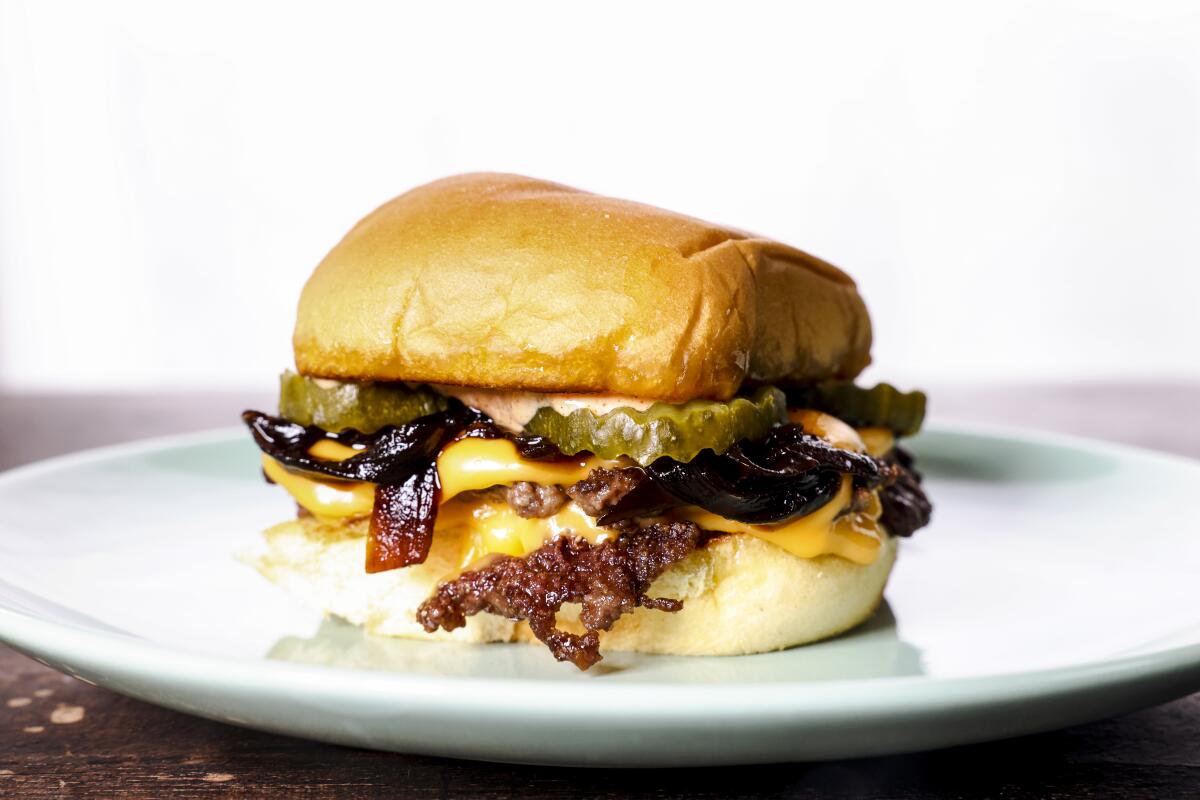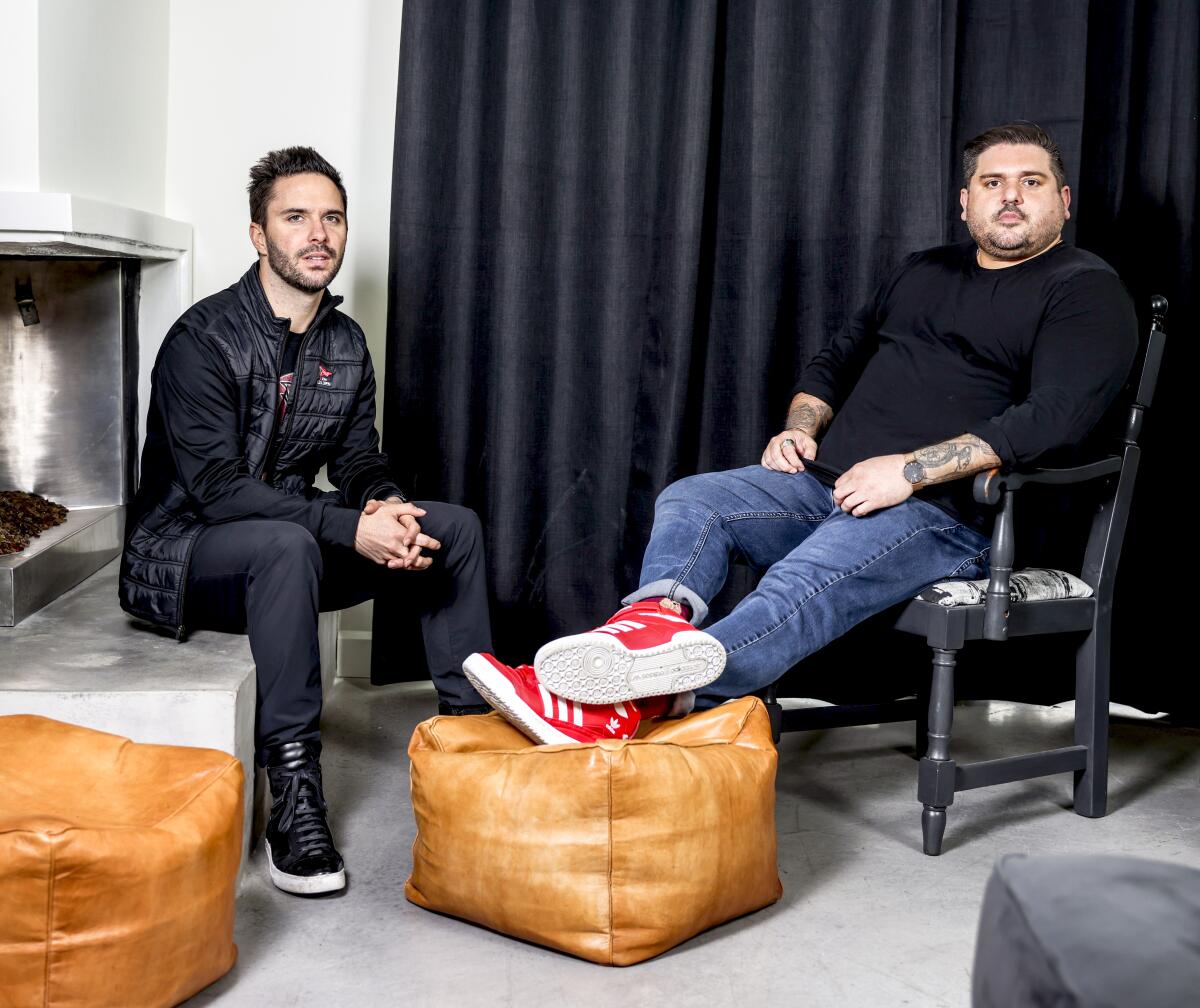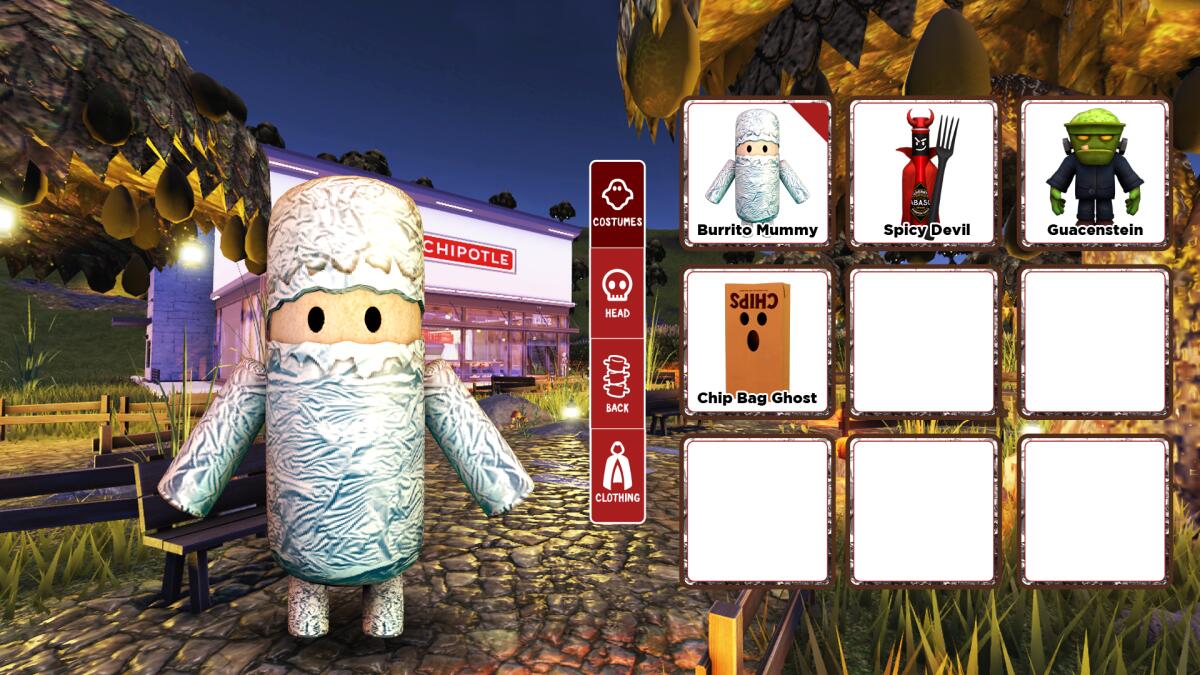NFTs could be the ticket to your next great meal

- Share via
Chef Brad Miller and restaurateur Luke Tabit have tested and eaten hundreds of burgers over the past six months. The two friends and former colleagues have experimented with countless varieties of cheese to observe how they melted, tasted numerous buns to make sure they didn’t fall apart, blended various mixtures of ground beef and consumed copious amounts of special sauce to create what they hope will be your new favorite burger.
Their Original Burger Boy just might be the Rolls-Royce of smash burgers, with each component souped up and fully loaded. The two patties are a precise blend of chuck and short rib. There are two slices of Borden American cheese (the cheddar and others just didn’t quite cut it) and exactly four Mount Olive dill pickle chips on the burger.
The caramelized onion marmalade that’s slathered on the meat is cooked low and slow with port wine for about an hour. Miller adds balsamic vinegar and continues to reduce the mixture; then he adds molasses and reduces it further before he layers in some thyme, liquid amino acids, liquid smoke and butter. The special L&B sauce, which goes on the bun, is a combination of smoked paprika, onion, tamari, lime, “secret spices” and mayonnaise. And it all comes together on a Martin’s potato roll.
Sounds good, doesn’t it? It tastes pretty great too. But if you want to try it, you’ll have to get crypto-savvy, school yourself on NFTs and enter the metaverse. A growing number of restaurateurs and food companies — including Budweiser and Chipotle — are experimenting with new technology to help market their brands. In the case of the Original Burger Boy, the IRL version will be available only after the owners reach their funding goals, which they hope to achieve, in part, by selling NFTs.

If you, like many of us, need to be reminded of the terminology in this relatively new marketplace, here goes: Cryptocurrency is a decentralized system of digital money based on blockchain technology. The metaverse is the persistent, online world that evolves and sticks around, even after you log off. You can experience it through various technologies including virtual reality and augmented reality, accessible through multiple devices such as phones, game consoles and your computer.
And NFTs? These are non-fungible tokens, a unique digital file that’s stored on a blockchain network. NFTs made news last spring when a digital collage linked to an NFT was sold in a Christie’s auction for more than $69 million. The artist was Mike Winkelmann, better known as Beeple. Needless to say, his celebrity is more evidence that NFTs have moved into the mainstream.
“Most people think NFTs are just weird art that you own JPEGs of,” said Jeremy Fall, a former Los Angeles restaurateur who is the creative director of @NFT, a Mark Cuban media company based around, well, NFTs. (Fall also started a brand called Probably Nothing that works to educate people about NFTs, Ethereum — the digital currency used to buy NFTs — and all things metaverse-related in a “simplified, approachable manner.”)
“What an NFT actually is, is a form of digital ownership that is authenticated,” he said. “In layman’s terms, when you buy an NFT, you own that piece of something that is stored in the blockchain, a database that encrypts and authenticates all NFTs.” You are, in essence, buying bragging rights — to digital art, video, etc. — because your item is the authentic one.
For many brands that release them — like Miller and Tabit’s L&B Burger Boy — NFTs involve real-life perks such as access to pop-up events, a virtual restaurant and first dibs on merchandise drops. They are, in essence, marketing their new concept in reverse.
Traditionally, there is a marketing push surrounding a bricks-and-mortar restaurant opening. There is likely an opening event where guests can try the food. Miller and Tabit wanted to create fans and a certain amount of buzz before anyone could actually try the burger in person.
Their launch plan depends on fans purchasing Burger Boy NFTs, a series of digital art pieces featuring the brand’s signature Burger Boy mascot in various outfits and situations. The two worked with designer Courtney Casas to come up with the “Classic Burger Boy,” a wide-eyed kid sporting some of Miller’s real-life tattoos, wearing a V-neck and shorts, holding a burger. There’s also a “Fancy Boy” featuring the same boy with a mustache and a top hat, a bow tie and a black deep V-neck and shorts. And then there’s “Moon Boy,” who wears an astronaut helmet and holds his burger in space.
“By using our website, lbburgerboy.com, you will be able to mint one of the fun, unique and very silly NFTs to become a part of the Burger Boy community and join us on our exciting journey,” according to a “roadmap” (the business plan) for the brand. Miller and Tabit hope to release up to 9,000 NFTs that will first be available to what they are calling a “whitelist” reserved for strategic partners that will include friends and family.
The duo haven’t settled on an exact price but said that NFTs usually range anywhere from .05 to .1 Ethereum to mint. At the time of writing this article, 1 Ethereum was equal to $3,234.74.
Assuming the NFTs sell out, the plan is to take a portion of that funding to create special events where NFT owners can try the burgers. “We’ll have pop-up events where whoever owns a Burger Boy NFT gets free access to the event, and burgers and fries are included with it,” said Tabit. “We’re talking about doing special events with top name DJs in cool event spaces.”

“We were going to do this burger concept anyway,” said Miller, who is the chef and co-owner of Inn of the Seventh Ray. He and Tabit worked together at a handful of Los Angeles restaurants that Tabit owns, including Ashland Hill and Ox & Son. Both restaurants served iterations of Miller’s burger.
“With the landscape of COVID, physical locations have become trickier and staffing has become tougher, and we were trying to think creatively,” Tabit explained. “We thought, how cool would it be to launch an NFT to engage the community, raise some capital and build the brand a little backward. You get the digital community involved, and you’re merging the culinary and the digital world together with a millennial audience.”
Once the brand recognition and funding reach a certain level, Miller and Tabit will start selling burgers out of ghost kitchens for about $7 a burger — and then via the metaverse. Guests will be able to visit a virtual restaurant with their avatars, order a burger and have it delivered in real life via a ghost kitchen.
“As a restaurant, you have your regulars and your locals,” said Fall. “I see a big parallel with how restaurants can incorporate NFTs in the food space. I think it’s going to be something that’s going to take a while to adopt. Big brands in general have larger budgets, but what’s going to be interesting is how it’s utilized on a more local level.”
In October, Chipotle launched a virtual restaurant and game called the Boorito Maze using the Roblox gaming company platform. It was a digital extension of the real-life Boorito costume contest the brand has been hosting in stores since 2000. Fans could sign on to the Roblox site and dress their avatars in Chipotle-inspired costumes such as a Chip Bag Ghost, Burrito Mummy or Guacenstein and then visit the virtual restaurant.
For each day of the promotion, between Oct. 28 and 31, the first 30,000 visitors received promo codes for a free entree to redeem via the app or online. The remaining visitors were given codes for discounted entrees that could be used on Halloween. Then users could visit the Boorito Maze to collect items that helped their avatars avoid monsters and reach the center of the maze to gain access to more virtual items such as foil bucket hats. Some were free, some were available for purchase using Robux, the cryptocurrency used on the Roblox platform.
“There was already a conversation around Chipotle there [on Roblox before the promotion] with fans already creating their own Chipotle-themed games, making items for their avatars and discussing them in groups,” said Tressie Lieberman, vice president of digital and off-premise for Chipotle.

The Boorito Maze game was visited by 3.5 million unique players during the October promotion, and Oct. 31 was the company’s highest digital-sales day of all time.
“We were thrilled with the engagement and to have that many fans not just talking about your brand but experiencing it. From the costumes to the restaurant and the virtual goods, it was a true experiential event,” said Lieberman. “We trended on Twitter twice during the event.”
More than 8.5 million people have visited the maze since it was launched in October, with people coming to the virtual restaurant and playing the game every day, without any free entree offers or discounts. “We looked at currency and NFTs and the broad suite of what’s out there,” said Lieberman. “We haven’t launched anything with NFTs yet, but it’s certainly something we keep top of mind.”
In November, Budweiser launched an NFT collection with 1,936 digital cans to commemorate 1936, the year of the first Budweiser can. Thirty-six of the cans, priced at $999, were gold and advertised as “hyper-exclusive” with “gold-only levels of access” to the Budverse, Budweiser’s metaverse. There also were 1,900 silver cans ($499) that unlocked “exclusive access and rewards” in the Budverse. Although none of the exclusive benefits for either can were identified when the cans were put up for sale, they sold out in less than an hour.
Two weeks after the release, some of the Budweiser cans were being listed on OpenSea — where NFTs land after their initial minting and can be resold — with a buy-it-now price of $400,000. Some potential buyers were offering $20,000, even though Budweiser still had not yet released the specific perks to be included with the purchase.
According to Utpal Dholakia, a professor of marketing at Rice University, NFTs are a result of several phenomena that occurred during the pandemic, including investing by millennial and Gen Z consumers, the popularity of cryptocurrency, investing in meme stocks such as GameStop and existing interest in gaming and gambling subcultures.
“If you consider NFT as a product, it really doesn’t have any functional value, i.e., it doesn’t provide any specific functional benefits to consumers,” Dholakia wrote in an email to The Times. “The NFT’s sole value lies in the possibility of future value appreciation and the chance that today’s buyer will earn a profit by becoming tomorrow’s seller. Herd behavior by NFT enthusiasts, many of whom tend to be cryptocurrency enthusiasts, is driving the appeal.”
For Fall, it’s about much more than the potential of appreciation. Though he calls himself a Miller High Life man, he is the original owner of one of the silver Budweiser can NFTs.
“The beauty with NFTs is that they can constantly evolve,” said Fall. “Now I’m engaged in the brand, and I’m connected and have ownership with it.”
Fall, who owned 12 restaurants pre-pandemic, is working on launching his own metaverse food experiences with NFTs and real-life tie-ins. One idea is called Photosynthesis, and it will focus on floral NFTs meant to be given to others and a multistory flower garden in the metaverse featuring a virtual restaurant. Though the focus would be on the digital art and the way it changes over time (your flower NFT might bloom or change color), the flower NFTs also would unlock certain perks such as real-life dinner parties in flower gardens with flower installations.
Fall also is planning the world’s first bagel shop in the metaverse, with NFTs that will allow access to a virtual store. “I want to capitalize emotionally on the fact that bagels are a very nostalgic food and try to take comfort food and translate it to a digital age,” he said.
Some NFTs will be rarer than others and feature specific bagel toppings. Eventually, digital restaurant visitors will be able to have a real bagel delivered to their house through specific collaborations with restaurants.
“I’m hoping,” Fall said, “that people in the food space see NFTs as an opportunity instead of worrying just about the food itself, and that they develop the context and communities and think about what they can provide, and focus less on the plate and more on what’s around the plate.”
Dholakia is skeptical, noting that almost every industry, including food, is “jumping on the bandwagon.”
“It is really hard to imagine what value a food-and-beverage-related NFT could possibly have for foodies or consumers,” he said. “Everything about the food industry, whether it is hospitality, consumer packaged goods, farming or something else, is totally contrary in essence to what an NFT is.”
Nonetheless, big brands and celebrity chefs are experimenting. In addition to Budweiser, Pepsi and Applebee’s have released NFTs. Tom Colicchio is pushing pizza NFTs and Martha Stewart is offering NFTs of images from her farm in Bedford, N.Y. They range in price from $100 to $1000.
In November, chef Shirley Chung of Ms. Chi in Culver City launched a series of dumpling NFTs along with food writer Andy Wang and culinary consultant and event producer Caryl Chinn as part of their Dumpling Mafia dining club.
“Chefs during the pandemic, we didn’t have as many opportunities to cook and be creative — we were just surviving,” Chung said. “Creating these NFTs is also kind of freeing my mind and giving me a way to submerge myself in art and a happy space. And I want to show chefs that innovation is really important.”
Chung is hoping her NFTs will help build a community around her Chinese culture and food. The NFTs feature artwork from artist Narrator (Daniel Munoz) and depict dumpling characters.
Dumpling Mafia NFT holders will receive discount codes to Chung’s upcoming virtual Lunar New Year event, which includes a cooking demo, frozen dumplings and a kit to make tang yuan together. There will also be an auction of NFT art to benefit #StopAsianHate organizations.
The trio are still working on future NFT holder perks but said a map featuring the group’s preferred dumpling-crawl stops around Los Angeles is a possibility.
“We are here to create a community and at the same time educate people to understand and share our dumpling culture and our Chinese American background,” Chung said.
More to Read
Eat your way across L.A.
Get our weekly Tasting Notes newsletter for reviews, news and more.
You may occasionally receive promotional content from the Los Angeles Times.











